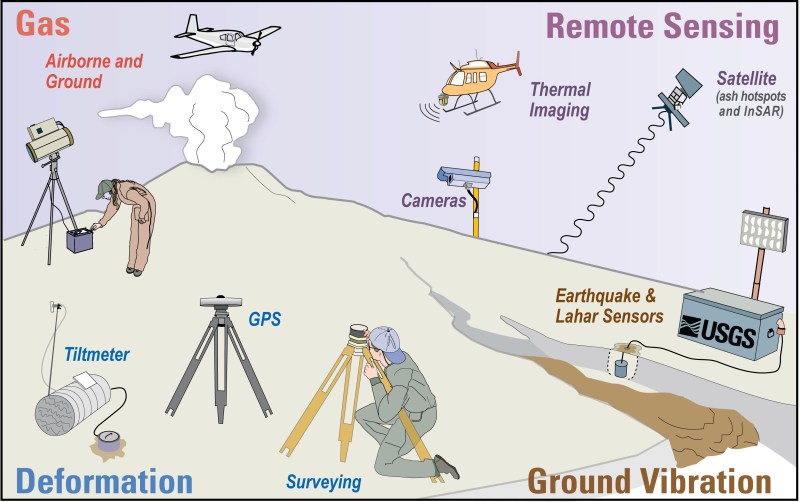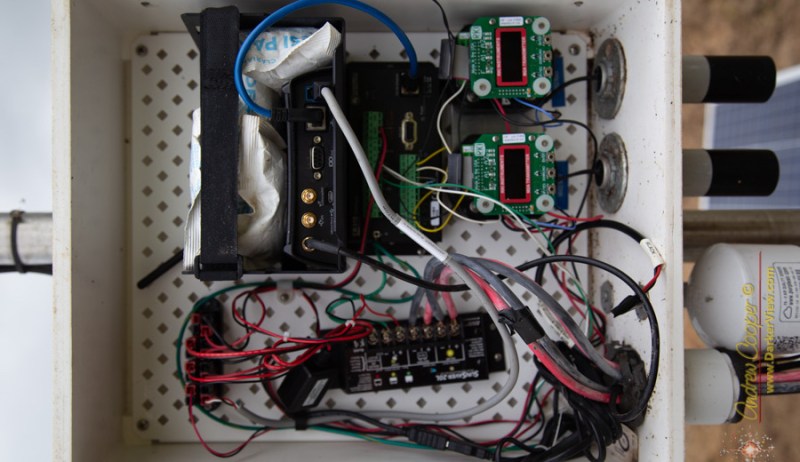On a recent walk through the Hawaii Volcanoes National Park, [Andrew Cooper] stumbled upon an unlocked monitoring station. Being an engineer, he couldn’t resist taking a look. This station is one of a network of sulfur dioxide (SO2) monitoring stations installed around the park to keep an eye on volcanic emissions. Unsurprisingly, sulfur dioxide is unhealthy to breathe. Sensors like these keep people informed about local conditions before taking their strolls among the volcanic foothills, enjoying gorgeous vistas as [Andrew] describes it.

[Andrew] wasn’t particularly surprised at the contents of the station, since he builds similar equipment in his day job. Continuous power is provided by lead acid batteries kept charged by an array of three mis-matched solar panels. There are duplicate SO2 monitors, an air particulate meter, and a standard weather station affixed to the top. Data is logged on-site and reported up the chain by a cell-phone modem. [Andrew] wasn’t impressed with the workmanship, noting:
It appeared as if the circuits were wired by a ham-handed grad student with no sense of pride in their work.
Tracking the atmospheric SO2 levels near volcanoes not only helps hikers and park rangers plan their outdoor activities. Gaseous emissions from volcanoes are one of a number of measurements that geologists rely on to monitor and predict volcanic activity, as this sketch from the USGS website depicts.

Have you worked on any projects involving unattended monitoring stations like this, or encountered them in the wild like [Andrew]? Let us know in the comments below.
















The wiring inside that box might work, but one bump and it won’t. I agree that the individual who wired it has zero pride in their work. To do things right does take longer, but not that much longer, and the result is something you are proud of.
This device is of the ilk that if you showed a photo of your ‘previous work’ to a prospective employer (as many now require), you’d be lucky to ever get a job again.
I would consider it a pass as a teenage child’s science project 20 years ago, but honestly some zip ties and heat shrink would go a long way
its pre-engineered modules glued together with spegetti, design something and for just under 30 bucks you can have 10 samples in your hand in roughly 2 weeks … it took longer to wire that and no one will ever figure it out 2 weeks later
Personally, I’m not so offended by the craftmanship here. In all likelihood, this was done by someone who wasn’t getting paid for it, and whose day job is not electronic engineering. If it breaks, they’ll probably fix it, and everyone else gets the benefit of its existence for free.
If you actually do this type of work for a living and you think the public need a better system, I’m pretty sure you could donate your time and resources to build a better one, and it would be greatly appreciated.
You seem to be making a value judgement based on a single, not very well focused, photograph of something whose operational specification is not referenced. I agree, if continuous operation was required in a high vibration environment, this unit might not stay operational for very long. On the other hand, if it meets the task requirements – for example to gather valid data, communicate it as necessary, meet cost and MBTF targets and be easy to modify – then I’m not sure that your comments are relevant. Does the unit work better if the electricity runs down carefully loomed wires that are clipped every 5 cm to a rail? Do the wires need to turn corners at right angles? Do the solar panels have to be “matched”? Above all, does it work?
Aesthetic needs may not need to have such an influence on equipment construction as other design parameters and we need to be aware of our own prejudices to be capable engineers.
And if I might make a comment about photographs of “previous work”. If someone showed me a photograph of this at an interview, I would be delighted that some practical capabilities were in evidence from the candidate. I would ask about the design criteria, the documentation, the construction trade-offs that had been considered and what knowledge had been gained from involvement in the project. My narrow view of what constitutes “doing it right” would hardly foster creativity and innovation and I’m not sure that a profusion of Ty-Wraps axiomatically adds to the value of a project. As someone said – “evidence, always evidence. All else is assumption”.
That is very true (the comments about the photos of ‘previous work’). It may be the budget was zero and “here are the bits you have to work with”.
…It could be that you show such a photo to prove “I’m the guy that can cobble together anything with nothing”.
That statement also applies to most of HaD feature projects which have much worse wiring.
There are a few exceptions. e.g. the auto-driving bicycle from China.
NOAA has a ton of unmanned/remote weather stations. The last one I looked at the components were all mounted well but the wiring was somewhat of a rats nest – some tie-wraps and a bit more care would have cleaned things up.
The stations report weather conditions home once an hour, many use some sort of satellite link and others seem to use a standard cell phone data connection
“… who wasn’t getting paid for it”
That’s it.
We live in a society which spits on you if you haven’t any money, but then expects you to do good work for little or no pay.
Somethin’s gotta give :-)
Don’t forget, “permanent” is six months, “temporary” is five years.
That wasn’t supposed to be a reply. It was supposed to be a new message. Hackaday comments system strikes again.
What. A. Mess.
You can understand why they normally keep those boxes locked.
I MIGHT accept that as a quick and dirty build as a proof-of-concept, or as an emergency replacement, but certainly not for production use.
The use of tie wraps is an absolute must – even 2 minutes with a drill to mount the crooked components straight would be an improvement!
Do tell please ….. Why would “mounting the (crooked) components straight” be better? Would it make the data the unit gathered more valid? Would it meet some other requirement that is important to the operational spec (that I don’t know about) ?
This is really not an attempt to be obnoxious – I’m just interested in your chain of reasoning
In some jurisdictions this would be considered unlawful entry. Sometimes it’s cheaper to have many poorer-quality sensors, some of which might fail from time to time with no significant adverse impact, than fewer sensors constructed to commercial standards.
Which jurisdictions would those be?
If that was put together by a geologist that’s pretty good job.
They probably have departmental budget for the components, but not for an electronics engineer to do it “to code” or make it look aesthetically pleasing.
It would take more than ‘a knock’ to make it not work, I think.
Having done a lot of work with Campbells Scientific gear, This level of assembly is almost expected straight from the CS assembly depot. I’ve got 14 CS sites at the moment, each supposedly identical, but every one is wired subtly different.
Not like every part of the government gets Pentagon monies!
Was there any way to determine that this was an “official” USGS or national park sensor? This could have quite well been some high school student’s science project, youth group (boy/girl scouts) or other amateur hobbyist project. Hopefully in either case they got permission from the park ranger to leave it.
In my line of work as a low voltage tech plenty of times I have made super clean installs then to return years later that my hard work turned into a total mess from other trades, customers and people that shouldn’t of been messing with it.
That box was unlocked.
Who knows how long it has been out there and other people messing with it along with repairs and maintenance work done to it since it was deployed.
Missed a good headline there, should have been:
Peaking inside a volcano sensor….
I wonder if you could produce panic by lighting a bunch of sulfer matches next to that sensor.